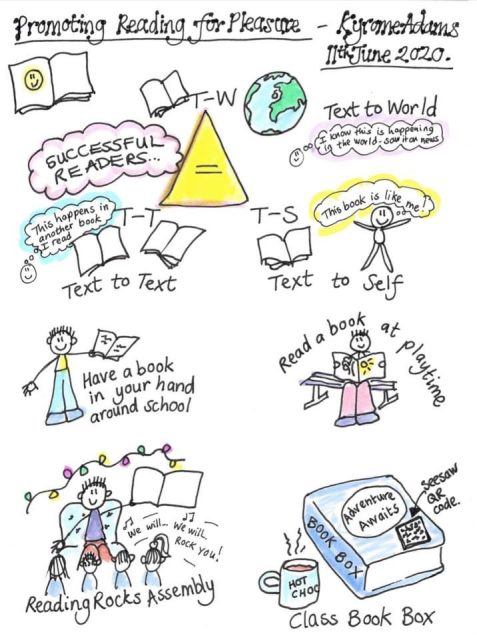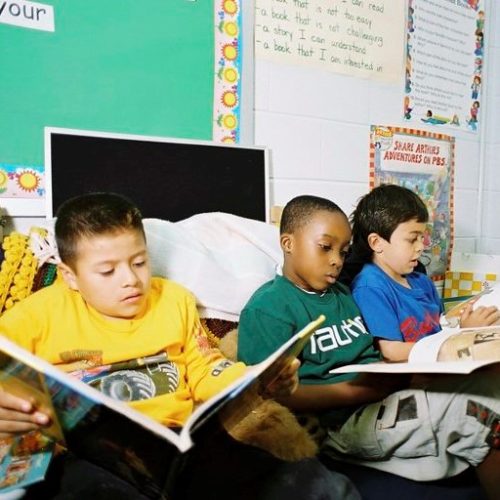As an author, I regularly visit schools to deliver creative writing workshops. What I’ve noticed, is that it’s obvious when there’s a strong reading culture within the school.

It’s not only that there are books, and references to books, everywhere you look, but there is also a marked difference in the children’s attitudes towards writing. And this is something I’ve found particularly exciting.
In a school with a strong reading culture, the children are more enthusiastic to meet and work with an author.
This is more so than in a school where reading does not take such prominence. I’ve noticed too that the children’s interest in books and reading transfers to their attitudes towards writing. As such, they’re more enthusiastic and willing writers, often confident and competent too.
For me, someone who spends her time encouraging children to enjoy writing, this is a lovely thing to see.
I remember a few years ago when my eldest daughter was in Year 8, the policy at her school was for the children to read for five or ten minutes before the start of every lesson. At the time, she told me about it because she enjoyed it so much. She said it helped focus her mind for the lesson ahead, and I guess this was the point of doing it. I imagine this type of approach worked well for both teacher and pupil.
Thinking about this, and also my most recent school visits, I wanted to put something together about how you can create a reading culture within your school. This is something I feel is so important and can have a huge significance in all aspects of school life. With this in mind, I asked the good people of Twitter what their thoughts were on the matter. Thankfully, they came up trumps by giving me lots of recommendations and I’m going to share them with you here.
Creating a reading culture in a school requires the involvement of everyone. And that includes staff, governors and the families of the pupils themselves.
As a teacher, reading children’s books is a must. Be seen reading them, talk about what you’re reading and show how passionate you are about them. By engaging in conversation with your students, you can get to know what they enjoy reading. As such, you can recommend books specifically for the individual, books you know they will enjoy.
Make time every day for reading aloud. Children love having books read to them and it is a crucial part of the reading for pleasure culture. This could be during form time/registration or as a wind-down activity at the end of the day. It doesn’t have to have anything to do with the current curriculum you’re studying.
Having dedicated spaces for reading is important. Some schools have a reading corner, others a reading room. Regularly change them around to make sure you showcase a variety of different books. Children love to lounge about when reading, so lots of beanbags and cushions will really appeal. In addition to having these reading spaces, put book blurbs on the dinner tables and things like story openings and book reviews on the walls around the school.
Commit funds to a school library and expertise to run and fill it. I cannot stress enough, the importance of a library. The consensus on this one is that it should be a must, not a nice-to-have. Not only that, regular visits to the local library can help make books accessible to those children who do not get access to them at home.
Let them read all types of material.
This one is close to my heart, having a reluctant reader among my flock. Reading novels was always a struggle, for whatever reason that may be, but she loves Manga and has read so many of these books since discovering it. Graphic novels, pictures books, poetry, verse novels, non-fiction, there are so many different reading formats, so why limit to just one? Don’t forget audiobooks too.
One of my favourites (and I promise I didn’t make this up) is to give priority to funds for visits from authors, poets and storytellers. The reason for this is to bring stories alive. It also helps children to see authors as real people. They can ask them questions. Also, they can put a face to the name when reading the books. It can do wonders to help garner enthusiasm about reading and writing in general.
Forming reading buddies between staff and pupils can help encourage the more reluctant of readers. Recently, I went to a school where the Head reads with the children daily. I thought this was lovely as it makes the leader of the school seem so much more approachable and involved. When I was at junior school, you only ever went into the headmaster’s office if you got told off, so it was a scary and elusive place. The only other time we seemed to see him was at assembly.
As I have already said, forming a reading culture is not all down to the teachers.
Getting the kids involved is an important part of the process. In addition, it creates ownership and responsibility on their part. One idea is to have reading champions. This would be a group of children (not only the enthusiastic readers) who work together, with each other and with staff, to encourage reading across the whole school.
Another idea is to get the kids to write book reviews. This enables them to share their recommendations and experiences of reading. A book recommendation from a teacher is one thing, but a recommendation from a peer is quite another.
Children who read at home, or are read to at home, are more likely to enjoy reading.
That’s why getting parents and families on board too is important. Parents can be guest readers at the school. They could also be encouraged to get involved in book fairs and reading challenges. Educator, Jon Biddle, who dedicates his life to encouraging reading for pleasure, has lots of information and ideas on his blog. I particularly love the Mystery Book idea aimed at parents.
Yes, I know this is not an easy one. I was a volunteer reader at my children’s school when they were little. Whilst there, I often read with kids whose parents never read with them at home. Reading books would go into the book bags but were never touched. They were the children who struggled to learn to read and who struggled to engage with books too. As a mum, I know what it’s like to have a child who is reluctant to read the reading scheme books. That doesn’t mean I didn’t read with my child though. And parents need to know there are other ways to engage with reading that can help their children.
Working together as a whole school, where everyone is on board, is the most successful way to encourage a reading culture. And I can’t recommend it highly enough. The schools I’ve seen that promote this are such joyful places and the children so happy. It could be just a coincidence, but even so, I’d like to think that they’re connected in some way. I hope the tips on here can help you create this within your school.
Get in touch with me about an author visit, virtual or in person. Check out the rest of this blog for some fun creative writing exercises.


0 Comments